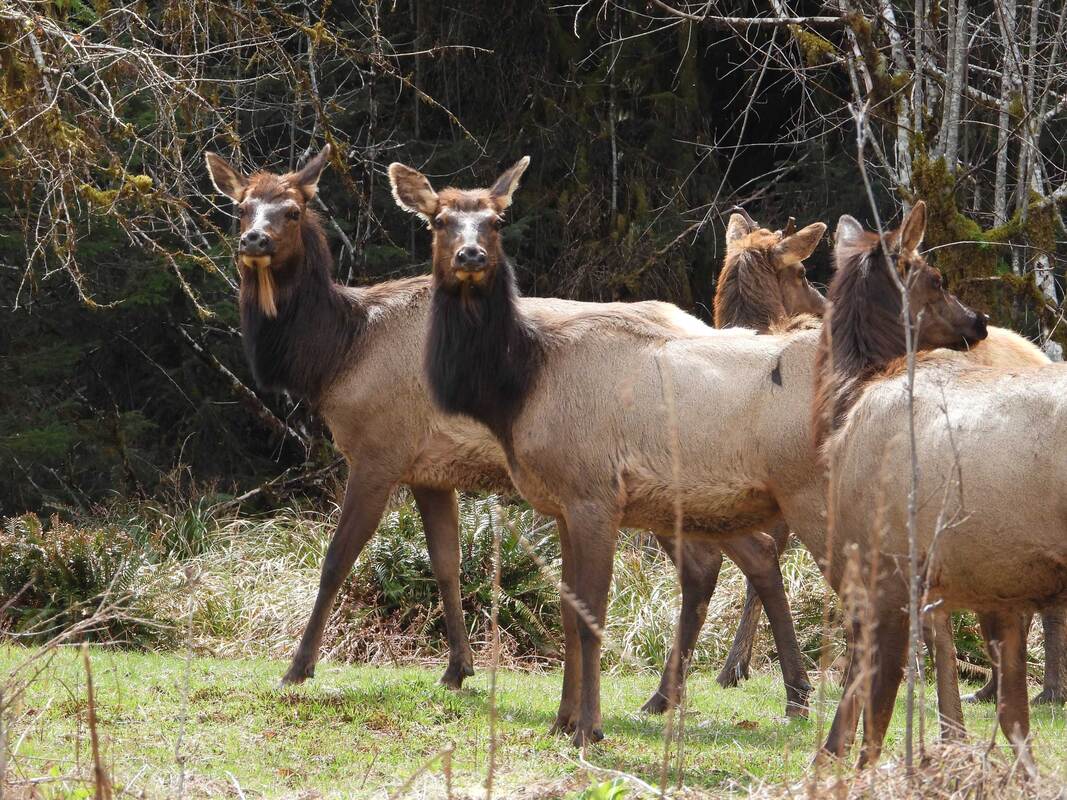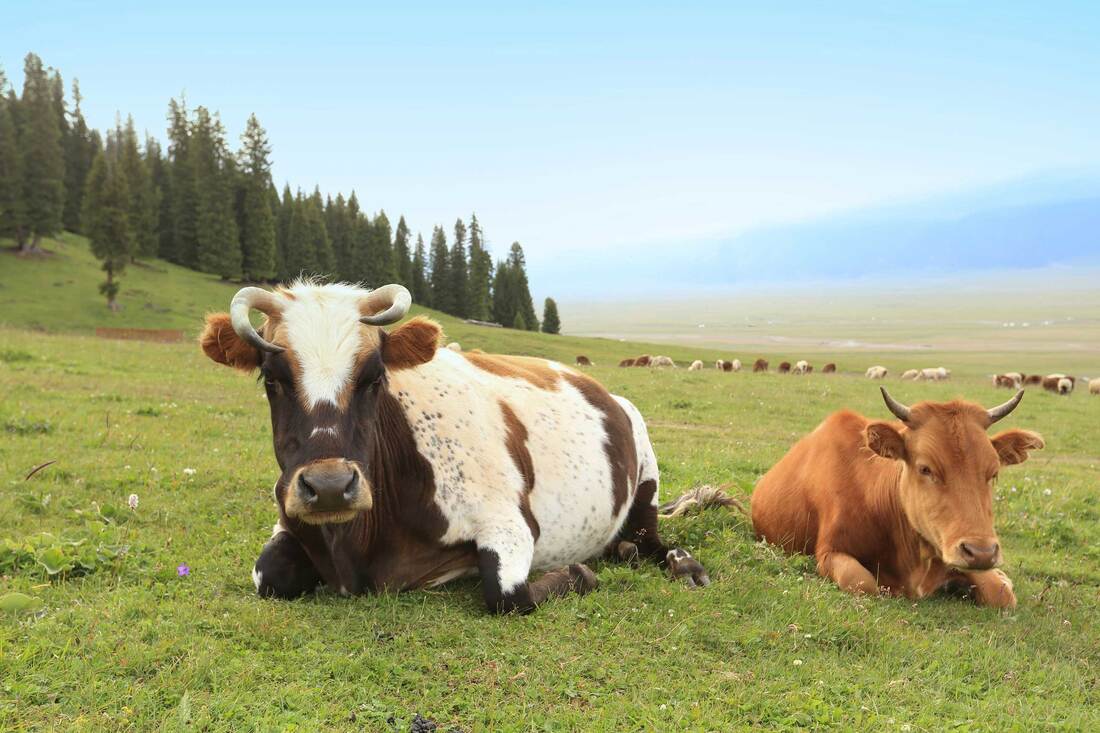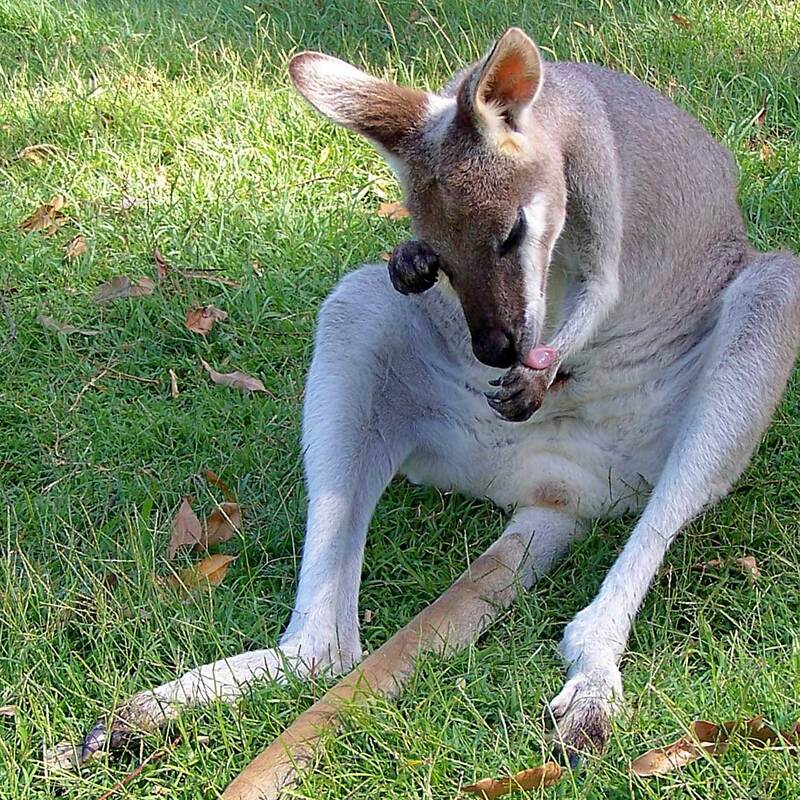|
The cicadas seem to be winding down here, so I'm posting about them one more time. In Part 2, I discussed how periodical cicadas know when 13 (or 17) years have passed. Now, let's consider how—after the allotted number of years—they know how to emerge within just a few days of all their fellow cicadas. Seriously... one day the forest is silent, the next day the cicadas are emerging and singing to the whole world (well, singing to attract a mate anyway). How do they all get the memo at the same time? In my previous post, I stated that they emerge when the soil temperature reaches about 64ºF. True, but this can only be part of the story. Think about it... different areas of the soil reach 64º at significantly different times. Any area shaded by trees will be much slower to reach 64º. Deeper soil will also be much slower (cicada nymphs hang out underground for 13 or 17 years, but some of them are only a few inches deep, others are up to 18 inches deep). So, soil temperature alone does not explain how the cicadas emerge within a few days of each other. Based on numerous observations of real cicadas, mathematicians and biologists at Cambridge created a complex mathematical model of a huge underground cicada brood. This allowed them to tweak different variables, one at a time, to try to discover what would allow the cicadas to emerge together, as real cicadas do. After tweaking numerous variables, the scientists concluded the only thing that allowed the cicadas to emerge at the same time was if the insects were capable of communicating with each other underground. In the computer model, they gave the buried cicadas the ability to eavesdrop on the other buried cicadas near them. If the nearby cicadas (in slightly warmer soil) began making noise as they started climbing out of the soil, then the cicadas in slightly cooler soil were more likely to think, "Okay, I guess it's time to party!" (that's what I imagine cicadas are thinking after waiting 13 years underground for their time to emerge and finally mate). Anyway, this computer model could only produce simultaneous emergences (like we see in the real world) if the scientists gave their simulated cicadas the ability to communicate underground. Okay, well... we do not KNOW if real cicadas can communicate underground. Observing this will be difficult, but I'm sure biologists will come up with a way to do it. And I won't be surprised if the computer model turns out to be correct and underground cicadas really do have a way of talking to each other (maybe with clicking sounds?). The mysteries of nature are endless, are they not? Photo Credit: 13-year cicada - Stan C. Smith
0 Comments
How do 13-year cicadas know when it’s time to emerge? Much of Missouri is inundated right now with noisy 13-year cicadas (the 17-year cicadas are mostly to the north and east of Missouri). BIG QUESTION: How do the cicadas know 13 years have passed? Seriously, most of them emerge within a few weeks of each other, after living underground in isolated darkness and silence for exactly 13 years. It’s mind blowing. First, let’s look at WHY cicadas emerge all at once. This answer is simple—they do it to avoid being eaten before they have a chance to mate. Cicadas are not only defenseless, they are tasty and nutritious. Other animals snarf them up like a Las Vegas buffet. Well, cicadas need to emerge at the same time so that they can find each other as adults (so they can mate). The problem is, emerging at the same time creates a huge feeding frenzy among their predators. The solution? Emerge in such massive, incomprehensible numbers that predators cannot possibly eat them all. This is why we have periodical cicadas, a group of nine species of cicadas (out of more than 3,000 species worldwide... the others are annual cicadas) that time their emergence so that there are simply too many for predators to eat. This behavior is a rare and amazing adaptation. Okay, back to the question of how periodical cicadas know when exactly 13 (or 17) years have passed. As it turns out, we still don’t understand the whole story. We DO know that cicadas emerge when the soil temperature (at 12 to 18 inches deep) reaches about 64ºF in the spring. But that doesn’t explain why 13-year cicadas refuse to obey that urge every spring until the 13th year of their life. The leading hypothesis suggests cicadas are using tree chemistry to mark the years. For 13 (or 17) years, cicada nymphs live underground, slurping up the juices from tree roots. Each spring, when the trees produce flowers, the juices become rich with amino acids. The cicadas, of course, can detect this chemical change. Here’s proof: researchers took some 17-year cicadas that were 15 years old. The researchers altered their trees so the trees would flower twice in one year. As a result, the cicadas emerged a year early (at 16 years instead of 17 years). Proof that the cicadas count the number of times the trees flower, based on the surge of amino acids in the root juice. However, we still don’t know how the cicadas TALLY these annual events. Do they put little chalk marks on the wall of their burrow? Doubtful, but there has to be some explanation, right? Gotta love mysteries like this! Photo Credit: 13-year cicada - Stan C. Smith The cicadapocalypse has definitely arrived. We live in a fairly dense area of Ozarks forest, and cicadas are taking over here. It's quite astounding, actually. Below is one of millions of periodical cicadas invading our forest, making it so loud outside that, at its peak in the afternoon, it literally hurts the ears. Let's learn a bit more about these ear-splitting creatures. First, I'll point out that periodical cicadas are not the same thing as annual cicadas (which are much larger). Missouri has at least seven species of annual cicadas. They emerge later, in the dog days of July and August, and they can be quite loud also. However, a significant emergence of the much smaller periodical cicadas can be overwhelming simply because of their vast numbers. Missouri has several species of 13-year cicadas (this means the nymphs live underground for 13 years, feeding on tree roots, before they emerge, transform into winged adults, and seek out a mate before dying). Biologists tend to lump periodical cicadas into groups called broods, based on when they emerge. The largest brood in Missouri is called Brood 19. This brood is emerging now (May into June, 2024). These are 13-year cicadas, so the last time Brood 19 emerged was in 2011, and before that was 1998. Brood 19 actually includes four species of 13-year cicadas, and it is, by far, the largest brood in Missouri. Brood 19 is also called the Great Southern Brood because they emerge in fifteen states throughout much of the southeastern U.S. At the same time, Brood 13 (consisting of 17-year cicadas) is emerging in parts of Iowa, Wisconsin, northern Illinois, and northwestern Indiana. In some areas, Brood 19 and Brood 13 actually overlap, emerging together—the last time this happened was when Thomas Jefferson was president, in 1803. So, on our property now, the ground is riddled with round holes where the cicadas emerged. Turkeys and other creatures (including squirrels, frogs, birds, lizards, and some snakes) are taking advantage of this rare treat by gorging themselves on the cicadas. Wait... squirrels? Aren't squirrels herbivores? Yes, but they are also opportunistic carnivores, often eating insects and other small creatures when they have the opportunity. I have even seen a squirrel attack and eat a small bird. Isn't nature amazing? Photo credit: 13-year cicada - Stan C. Smith Did you know some female dragonflies fake their own death to avoid having sex with a male? In moorland hawker dragonflies, the males are often so aggressive that the females risk injury or death during mating. Females, when faced with an aggressive male, will freeze in mid-air, crash onto the ground, and then lie there without moving.
This doesn't mean the females don't mate at all, but they don't want to mate a second time after they've already laid their eggs. Here's the story. When summer begins to heat up, male moorland hawker dragonflies gather at the edges of ponds. When the females approach, the males aggressively pounce on them. The most aggressive males are the ones that get the females. So, the males have evolved to be very aggressive. After mating, the male leaves, and the female lays her eggs. However, as the female leaves the area, often another male will attempt to pounce on her. This is when the female fakes her own death. After all, there's no reason to risk injury or death after she has already laid her eggs, right? And this trick works. Researchers found that more than 60% of females faking their own death successfully escaped the pouncing males. Then, when the researchers approached the "dead" females, the females immediately flew away—proving they were perfectly fine and alert through the whole process. And, 100% of the females who didn't fake their own death were caught by males. This phenomenon is called sexual death feigning, and it has been observed in a few other animal species. However, in praying mantises and a specific type of spider, it is the males that fake their own death, to avoid being cannibalized by larger, aggressive females. I’m being serious here. Think about it. Those little strips of paper are in perfect shape when you crack open a fortune cookie. They don’t have moisture stains from being put into the cookies while the cookie dough was still moist and flexible. They aren’t stuck to the baked dough, as you might expect if they were put in when the dough was moist. And the papers show no signs of burning or heat discoloration from when the cookie was baked. This is, indeed, a great mystery.
First, let’s look at the origin of fortune cookies, which in itself is a bit of a mystery. Some fortune cookie experts believe the tradition was inspired by 14th century Chinese rebels fighting Mongol invaders. According to legend, a Taoist priest and his followers sent critical messages back and forth hidden inside of Chinese moon cakes. Other experts believe fortune cookies came from Japan, particularly rice cakes that had paper fortunes stuffed inside. These were made at the Hyotanyama Inari shrine in the 1800s. Still other experts believe the idea started in the 1800s in the United States, when Chinese railroad workers handed out small cakes containing notes with holiday wishes. Regardless of where the inspiration came from, it is generally agreed that, in 1914, a man named Makoto Hagiwara, who owned a Japanese tea garden in San Francisco, started serving tea and fortune cookies. So, modern fortune cookies are as American as baseball and apple pie. Let’s get back to the original question of how the fortunes get into the cookies. As it turns out, the process is simple. The cookies are baked before inserting the fortunes. The key ingredient that makes it work is the sugar. Originally, when fortune cookies were made by hand, the dough was flattened into a three-inch circle and then baked. When still warm, the cooked dough remained flexible. The paper fortune was placed on the warm, fresh-baked cookie, then the sides were folded over using chopsticks. The timing was important because the sugar would cool quickly and the cookie would become hard, with a shiny surface. In 1974, Edward Louie invented a machine that would automatically insert the fortune and then fold the cookie. Soon, as the machines improved, fortune cookie bakeries were using machines that could produce 8,000 or more fortune cookies per hour. Now and then I get one of these cookies without a slip of paper inside—it's my misfortune. On our recent trip to Washington state, Trish and I visited the Quinault Rainforest. This is a spectacular temperate rainforest (a rainforest in a temperate region, usually consisting of a mix of coniferous and broadleaf trees). We were lucky enough to come upon a herd of Roosevelt elk.
Roosevelt elk are the largest subspecies of the North American elk (Cervus elaphus). These huge mammals can weigh up to 1,100 pounds (500 kg), making them one of the largest members of the deer family (which includes deer, elk, moose, and caribou). Male elk grow massive antlers, which are shed after the mating season each year. Keep in mind that antlers fall off each year, whereas horns are permanent. One exception is the North American pronghorn, which grows horns, but the horn sheath falls off and is regrown each year. Anyway, male elk shed and regrow their massive antlers annually. If you look closely, you'll see that the third elk from the left is a male just starting to grow its new antlers. Roosevelt elk are named after President Theodore (“Teddy”) Roosevelt. Did you know cows often face north or south while grazing? I didn’t realize this until I read a National Geographic article about it recently. Scientists have limitless curiosity, and a team recently examined thousands of Google Earth satellite images. They realized something humans had heretofore never really noticed on a large scale. Grazing and resting cows often line their bodies up along the Earth’s magnetic poles. Not always, of course, but enough to establish a general pattern. Grazing and resting cows usually face north or south. Why? How? This pattern happens on all six of the cow-inhabitable continents, and it’s consistent regardless of the terrain or other factors like wind or the angle of the sun. (disclaimer: this is not a universally accepted phenomenon—some scientists suggest more data needs to be collected before it is conclusive).
As it turns out, nobody really knows why cows do this. Some animals, particularly birds, bees, and fish, have an internal compass, but this is the first evidence of an internal compass in a large mammal. Interestingly, the closer the cows are to the north or south poles, the less accurate they are with their orientation. Apparently, their internal compass works better the nearer they are to the equator. Some experts suggest this is somehow related to navigation. Maybe, in the distant past, cow ancestors used this compass to migrate, or to find their way home every day after grazing over a large area of land. Other experts suggest it is some kind of strategy for avoiding predators, perhaps allowing the cows to keep themselves spatially oriented in herds (kind of like fish schooling behavior). I wonder what happens to cows if they can’t orient themselves north and south, such as in some feedlots. Does this stress the cows and make them less healthy? I am going to add my own hypothesis (as silly as it might be) to this unsolved mystery. I’m not a cow expert, but I get the impression cows like routine, and they like uniformity. Maybe, just maybe, they orient themselves so that they are always doing something familiar, like they did yesterday and the day before. So, they orient themselves to be just like all the other cows in their herd. Maybe cows feel comfortable being just like all the other cows. Individuality does not seem to be a thing with cows. Did you know kangaroos cool themselves by licking their arms? Many kangaroos in Australia live in extremely hot places, often over 100 degrees Fahrenheit. In these conditions, large mammals can have a hard time keeping their core body temperature from getting too hot. Many mammals, like humans, moderate their temperature by sweating.
Kangaroos are unusual in that they sweat when they are hopping (the kangaroo version of running), but when they stop hopping, they stop sweating and switch to panting instead. They pant at up to 300 breaths per minute, which keeps air flowing through their windpipe to cool their interior. But sometimes this isn't enough, which is when kangaroos start licking their forearms. Kangaroos have special networks of densely packed blood vessels just under the skin of their forearms. When they moisten their arms by licking, the saliva evaporates, cooling the skin, which cools the blood just below the skin. This cooled blood then travels throughout the rest of the body, cooling the entire kangaroo. Cool, huh? Trish and I recently enjoyed a week-long trip to Washington to explore some of the northwest coast and visit our son and daughter-in-law. One of our more colorful stops was the tulip fields of the Skagit Valley north of Seattle. This scene is from the Roozengaarde farm.
Each year, about 1,000 acres of tulips are grown in Skagit County, producing about 20 million bulbs that are harvested each summer. Another 75 million cut flowers are raised in greenhouses and fields. This is about 75% of all tulip production in the US. Every April they have the famous Tulip Festival, drawing about 300,000 attendees (including us this year). Surprisingly, the tulip bulbs and flowers generate about $20 million in gross income, but the month-long Tulip Festival generates $65 million for the county. The tulip, which is native to Central Asia, is in the lily family, and it is closely related to onions. Over a thousand years ago, tulips were cultivated in the Ottoman Empire (Turkish empire). The first bulbs were taken to Europe in 1556. In 1593, a botanist took tulips to the Netherlands. Tulips became extremely fashionable, and the wealthy paid high prices for them, leading to a period called Tulipomania (from 1634 to 1637). Eventually, tulips became affordable for the working class. They continue to be popular today. Tulips include more than 150 species and over 30,000 varieties. Despite all that, any time Trish tries to plant tulips in our yard, the deer promptly bite them off at the ground level. Okay, this one is the Big Kahuna of life’s great mysteries. The golden ticket. The pot of gold at the end of the rainbow. The prize at the bottom of a box of Cracker Jacks. The… well, you get it, right? This one’s a big deal. But am I afraid to address it? No!
Actually, this question has been answered by a few great minds. In Monty Python’s The Meaning of Life, a character opens an envelope containing the meaning of life. The character reads the contents: “Well, it's nothing very special. Uh, try to be nice to people, avoid eating fat, read a good book every now and then, get some walking in, and try to live together in peace and harmony with people of all creeds and nations.” Honestly, that’s a pretty good answer, in my opinion. In A Hitchhiker’s Guide to the Galaxy, a giant computer named Deep Thought takes 7.5 million years to contemplate this question, and it finally reveals the answer: 42. If you turn to a dictionary for the meaning of life, you’ll get something like: “The condition that distinguishes animals and plants from inorganic matter, including the capacity for growth, reproduction, functional activity, and continual change preceding death.” But this isn’t very satisfying, is it? The question has been answered in countless ways, and the answers depend on the lens through which a person views the question. Some people think it has to do with our potential and our ideals, and their answer might be: to live your dreams, or to expand your potential in life. Some people consider the biological aspects, and their answer might be: to survive, or to evolve, or to reproduce. Some people are concerned about wisdom, and their answer might be: to learn as many things as possible, or to seek out a reason to live. Some people are most concerned about being good, and their answer might be: to leave the world a better place than you found it, or to be honorable. Some people approach the question in a religious sense, and their answer might be: to understand the mystery of God, or to have a pure soul and experience God. Some people are focused on happiness, and their answer might be: to seek beauty in all its forms, or to enjoy every moment of life. Some people are all about power and self-improvement, and their answer might be: to know and master the world, or to strive for power and superiority. Some people believe that life simply has no meaning, and their answer might be: humans evolved randomly, and therefore there is no purpose or meaning, or… there is no meaning, and that’s what makes life so special. Finally, some people think we shouldn’t even try to answer the question at all… they might say: the answer is too profound and cannot be understood, or… you will never live if you spend all your time seeking the meaning of life. So, what are we to conclude? It seems to me that the answer is different for every person on Earth. You must find your own meaning. Darn it! Then how are we supposed to get it right on the test? Here is my own answer (although it could change as I change): Human life, having evolved by natural selection, has no predetermined meaning. However, we are fortunate to have the cognitive capability to contemplate our existence. Therefore, it would be a shame to squander this amazing evolutionary superpower. Humans are capable of making their own happiness, although the ingredients for such happiness are different for each human, as it should be. Personally, my purpose—the meaning of my life—is to achieve happiness and satisfaction. How? By striving to be a role model for others, by helping those who need my help, by loving my wife, kids, and others in my family, by experiencing and nurturing my awe of the natural world, by creating stories that entertain people, and by learning new and fascinating things. Anyway, there is definitely an answer to this age-old question. There is meaning to life, and it isn’t 42. It is something different for every person. |
Stan's Cogitations
Everyone needs a creative outlet. That's why I write. Archives
July 2024
|












 RSS Feed
RSS Feed